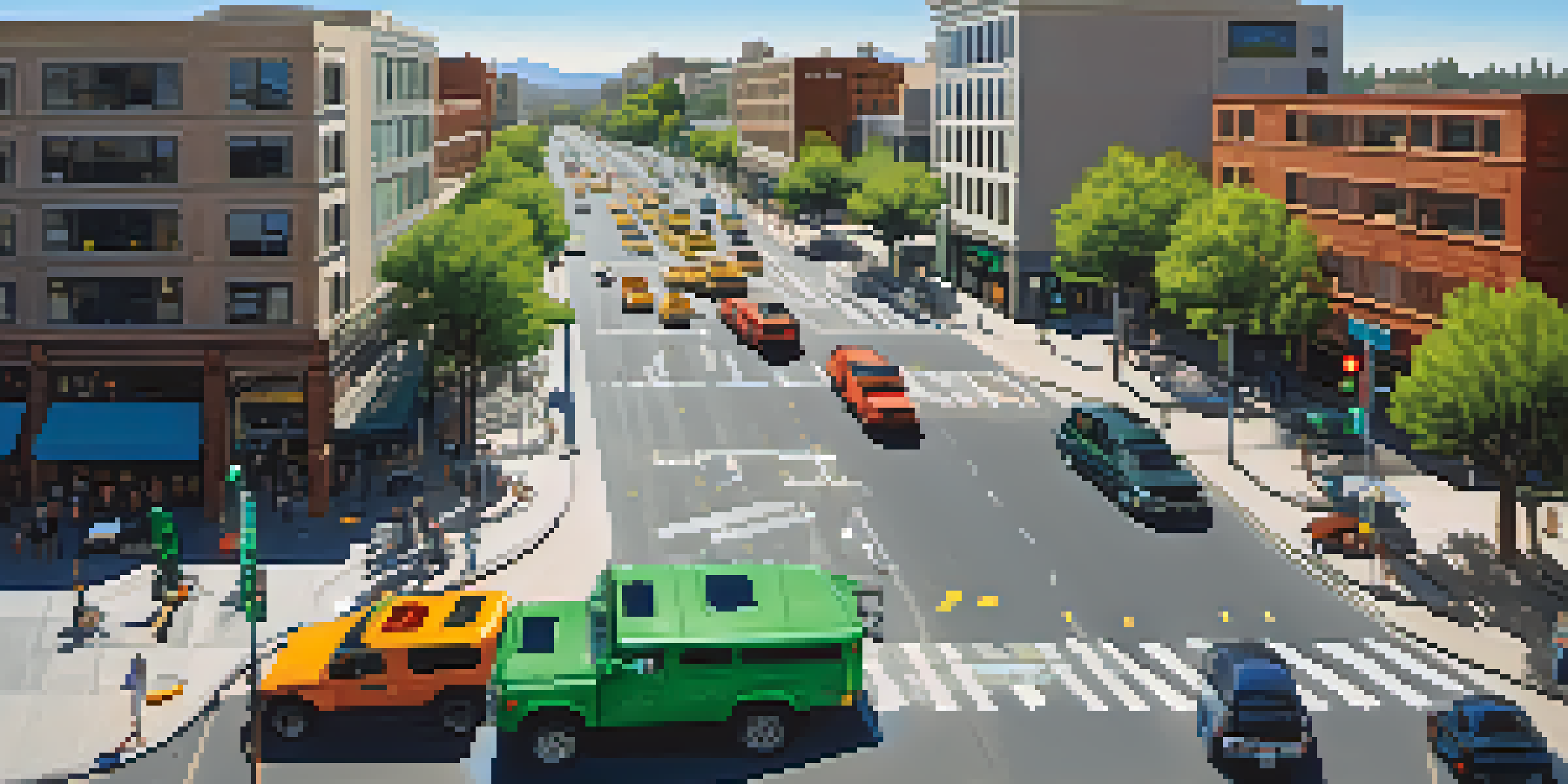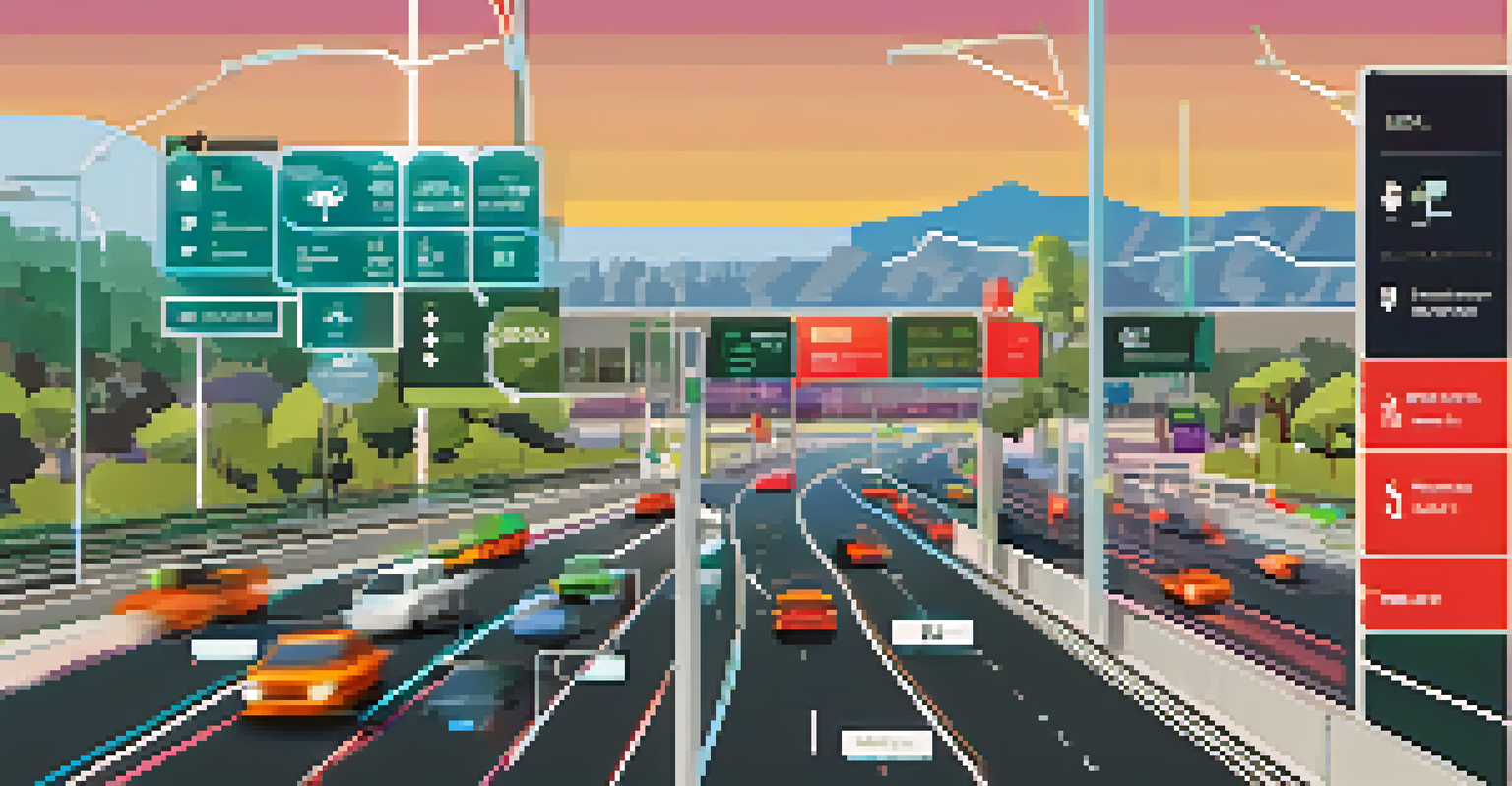Smart Transportation Systems: Reducing Traffic in San Jose

Understanding Smart Transportation Systems and Their Impact
Smart transportation systems (STS) leverage technology to enhance the efficiency of transportation networks. By integrating real-time data collection and analysis, these systems can respond dynamically to traffic conditions. Imagine a city where traffic lights adapt to the flow of vehicles, reducing waiting times and congestion.
The greatest challenge of the day is how to bring about a transformation of the transportation system to meet the needs of the 21st century.
In San Jose, the implementation of STS aims to alleviate the notorious traffic jams that frustrate commuters daily. With tools like smart traffic signals and real-time traffic updates, the city is working towards a more fluid transportation experience. This not only improves travel times but also reduces stress for drivers and passengers alike.
Moreover, these systems encourage eco-friendly practices by optimizing traffic flow. When vehicles move smoothly, emissions decrease, contributing to a cleaner, healthier environment. In essence, smart transportation systems represent a step forward in urban planning and sustainability.
The Role of Data in Enhancing Traffic Management
Data is the backbone of smart transportation systems, providing insights that help manage traffic more effectively. Sensors placed throughout the city collect information about traffic volume, speed, and patterns. This data is then analyzed to make informed decisions about traffic light timings and road usage.

In San Jose, this data-driven approach allows for a proactive response to potential congestion. For instance, if a particular intersection is identified as a bottleneck during peak hours, adjustments can be made in real-time. This agility minimizes delays and keeps traffic moving smoothly.
Smart Systems Enhance Traffic Flow
Smart transportation systems utilize real-time data to optimize traffic management, reducing congestion and improving travel efficiency.
Furthermore, the use of predictive analytics can forecast traffic conditions based on historical data. By anticipating peak times and adjusting accordingly, city planners can enhance the overall efficiency of the transportation network. Thus, data becomes a vital tool in the fight against traffic congestion.
Smart Traffic Signals: A Game Changer for Commuters
One of the most visible components of smart transportation systems is the implementation of smart traffic signals. Unlike traditional signals that operate on fixed timers, smart signals adapt based on real-time traffic conditions. This means that if there’s less traffic, the signal can change more quickly, allowing for a smoother flow.
Data is the new oil, and the smart transportation system is the refinery that turns it into a valuable resource for urban mobility.
In San Jose, these advanced signals are being strategically placed at crucial intersections. By prioritizing the movement of vehicles during peak hours, the city can significantly reduce wait times. Imagine driving through an intersection where the light turns green as you approach, rather than waiting for what feels like an eternity.
Moreover, these signals also contribute to pedestrian safety by providing them with better crossing opportunities. They can respond to pedestrian requests, ensuring that people can cross safely and efficiently. This dual benefit of improved traffic flow and enhanced pedestrian safety showcases the effectiveness of smart traffic signals.
Integrating Public Transport with Smart Systems
For a truly effective smart transportation system, integration with public transport is crucial. By synchronizing public transit schedules with real-time traffic data, cities can provide smoother connections for commuters. This synergy encourages more people to opt for public transport, reducing the number of cars on the road.
In San Jose, initiatives are underway to connect buses and light rail systems with smart transportation tools. For example, when a bus is running late, real-time data can adjust the timing of connecting services. This way, commuters experience less stress and can rely on public transport as a viable option.
Eco-Friendly Transportation Benefits
These systems promote sustainable choices by encouraging public transport use and integrating bike-sharing programs, contributing to a healthier environment.
Additionally, providing commuters with real-time updates about public transport can enhance user experience. Apps that show bus arrival times and delays help people plan their journeys better. This increased convenience can lead to a significant shift in how residents view public transportation.
Encouraging Eco-Friendly Transportation Choices
Smart transportation systems not only optimize traffic flow but also promote eco-friendly transportation choices. By providing real-time information about bike lanes and public transportation options, cities can encourage residents to shift away from single-occupancy vehicles. This shift is vital for reducing overall traffic congestion.
In San Jose, initiatives like bike-sharing programs are integrated with smart systems to enhance accessibility. With designated bike lanes monitored by STS, cyclists can navigate the city safely and efficiently. This not only helps in cutting down traffic but also contributes to a healthier lifestyle for residents.
Furthermore, the promotion of electric vehicles (EVs) through charging station networks can also play a crucial role. By providing accessible charging options and integrating them into navigation apps, San Jose can encourage more drivers to consider EVs. This holistic approach fosters a culture of sustainability among commuters.
The Challenges of Implementing Smart Transportation Systems
While the benefits of smart transportation systems are compelling, their implementation is not without challenges. One major hurdle is the cost associated with upgrading infrastructure and technology. Cities like San Jose must secure funding and resources to invest in smart systems effectively.
Moreover, there are concerns about data privacy and security. As systems collect vast amounts of data, ensuring the safety of this information becomes paramount. Residents must feel confident that their personal information is protected while still benefiting from improved traffic management.
Challenges in Implementation
Despite their advantages, the rollout of smart transportation systems faces hurdles such as funding, data privacy concerns, and the need for public acceptance.
Lastly, public acceptance and understanding of these systems are essential for their success. Engaging with the community through outreach and education can help alleviate concerns and encourage participation in smart transportation initiatives. Building trust and awareness will be key to the long-term viability of these systems.
Future Trends in Smart Transportation for San Jose
The future of smart transportation in San Jose looks promising, with ongoing advancements in technology and infrastructure. One exciting trend is the integration of autonomous vehicles into the transportation network. As self-driving cars become more common, they could significantly alter how traffic is managed in urban areas.
Additionally, the rise of artificial intelligence (AI) in traffic management is another trend to watch. AI can analyze data more efficiently than traditional methods, providing insights that lead to faster decision-making. Imagine a scenario where AI predicts traffic patterns and optimizes routes before congestion even occurs.

Lastly, community-driven initiatives will play a crucial role in shaping the future of smart transportation. By involving residents in the planning process, cities can ensure that the systems meet their needs. This collaborative approach can create a more sustainable and efficient transportation landscape for everyone.